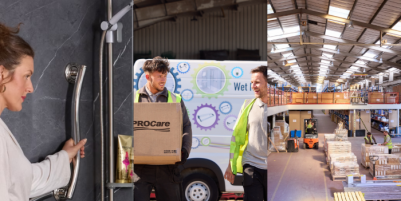-
AI startup Onton raises $7.5M to reinvent the way the world discovers and decides what to buy - November 26, 2025
-
Forklift Market Positions for Recovery as Confidence Expected to Build from 2026 - November 26, 2025
-
PROCare achieves 300% order capacity increase and 99% picking accuracy with Forterro’s ERP solution, Orderwise - November 26, 2025
-
DHL boosts operational efficiency and customer communications with HappyRobot’s AI Agents - November 25, 2025
-
STENA LINE TEAMS UP WITH CAMERA TELEMATICS TO DRIVE SAFETY IMPROVEMENTS AT IRISH SEA PORTS - November 25, 2025
-
Another design award for Toyota’s lithium-ion Traigo_i counterbalanced forklift - November 21, 2025
-
Stuut Technologies Raises $29.5 Million Series A Led by Andreessen Horowitz to Automate Accounts Receivable Work - November 20, 2025
-
INCREASED DIGITAL INVESTMENT REQUIRED TO KEEP PACE WITH 2026 CUSTOMS CHANGES - November 19, 2025
-
FULFILMENT SOLUTIONS FOR SPORTS MERCHANDISE: KEEPING OUR EYE ON THE GAME - November 19, 2025
-
COMPLEX, COSTLY & CONFUSING – THE END OF DE MINIMIS - November 19, 2025
Due to the e-commerce boom and the current general shortage of low cost labour, warehouse managers are under greater pressure than ever, says Eric Carter, Solutions Architect at Indigo Software. KPIs relating to improved warehouse efficiency, on time in full (OTIF) operations and target error reductions are becoming more challenging to meet. Introducing mobile computing in the warehouse, together with a warehouse management system (WMS) software solution is the answer. Here are some of the many reasons why mobile technology is now so widespread in the warehouse.
- We expect mobile connectivity. Just about everyone has a smartphone these days and even the oldest generation has some form of mobile device – albeit it may not be the latest model. Having real-time information at our fingertips and the ability to make decisions on the go has completely changed the way we live and work. We buy our groceries with our phones, engage in a whole range of communications, track our parcel deliveries and do many other every day business-related activities. Given that we rely on mobile devices so heavily, it’s natural to expect the same functionality in the warehouse too.
- They improve management control. In the past, warehouses would be run using paper and spreadsheets. People working in the warehouse had been there for years, they knew exactly what to do and when, they knew where to find stock and in some cases, they developed their own processes. Today, warehouses are far more fast moving and pressurised environments. Logistics processes are highly complex and fine-tuned to maximise productivity and efficiency. We don’t have time for one offs and operatives don’t tend to stick around for long. One of the advantages of using mobile devices is the potential to specify a particular workflow and in doing so, increase efficiency. Operatives can be assigned set tasks during a shift, set to work in particular zones in the warehouse, or required to perform particular quality checks. Time-consuming and manual interventions are no longer required since it is now possible to automate tasks using mobile technology. Mobile computers mean management have access to continual reporting to ensure tasks are being met as expected.
- Mobile technology eliminates human error. Implementing mobile technology in the warehouse guides operatives through key processes and removes common errors by capturing data at source and having built in checks. We call this checking quality into a process rather than it being an after-thought. Rather than keying in information post event, all stock movements and tasks completed are automatically reflected in the WMS and/or ERP system. In addition, tasks can be performed more ergonomically, which is better for the workers too. Technologies like voice directed working – commonly used for order picking – allow operatives to move about hands free. This is not only quicker, but safer, especially in cold chain warehouses.
- Mobile computing options exist for every requirement. A diverse range of devices exist. Some of the mobile technologies employed inside a warehouse include mobile RF computers, rugged tablets, mobile printers, and wearable barcode scanners. Here are some of the key benefits:
- Mobile RF devices and rugged tablets are designed for industrial environments and can work efficiently and reliably in extreme conditions. They offer long battery life and are typically data enabled, to ensure wireless connectivity even in warehouses without good wifi.
- Mobile printers provide the flexibility to create labels in situ from anywhere in the warehouse. Like mobile computers, they are ruggedised, feature long battery life, operate in real-time and offer excellent data connectivity.
- Wearable devices – voice headsets or wrist scanners – provide exceptional ergonomic and health and safety benefits. They are a more advanced alternative to RF devices and tablets and allow operatives to work hands free, for instance, responding to system generated commands whilst driving a fork-lift truck. They can be used for the full range of warehouse operations, from receiving and putaway to picking, sorting and dispatching. Although more expensive, wearable devices increase warehouse efficiency way beyond what is achieved with a standard RF device, especially in high throughout and extreme environments.
- Devices can be integrated with a WMS. One of the biggest benefits of using mobile devices is that they can be directly integrated with a WMS to support a fully real-time working environment in the warehouse. This means the WMS will generate sales order lists and assign pick zones to operatives that make sense according to the days order pool. The WMS will automatically ensure workers can social distance and the second a stock item is picked, it will be reflected within inventory records so that replenishments can be ordered immediately. Equally, the WMS can trigger label lists for mobile printers, supporting the dispatch teams. The benefits are very wide reaching.
Nowadays, with customers increasingly expecting same day deliveries and warehouses operating around the clock, mobile technology has become as essential to the smooth running of a logistics operation as our mobile phones are to us in our personal lives. Implementing a WMS integrated with mobile devices has been proven time and again to greatly improve efficiency and reduce task completion times. This means warehouses can scale up without having to increase headcount and can re-deploy their existing workers to focus on more value-adding activities.

































